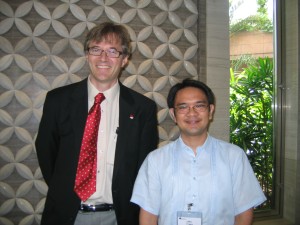Exonovation: Leveraging the Innovation of Others
December 16, 2008 Leave a comment
A few weeks back I was invited to attend an executive briefing on open, collaborative, community-based innovation. The speaker was Michael Tiemann, Vice President of Open Source Affairs at Red Hat. He titled his talk “Exonovation,” to avoid the connotation the word “innovation”, he says, has with internal organizational efforts at innovation. In his talk-he showed how organizations today (including his own company) are able to leverage the innovation of others to create sustainable competitive advantage that benefits not only themselves, but their community and industry ecosystem as a whole as well.
He gives examples of this happening in various areas, and cites as a historical precedent the development of the steam engine. He told us that as the technology in steam engines was opened up, so too did the number of its application expand. This resulted in a dramatic increase in its growth and development.

Later, he told of how this is becoming true of software as well-specifically with the emergence of open source software. With the emergence of open source, he says we are starting to see a shift from the traditional, closed-model of software development (with its emphasis in the creation and protection of proprietary intellectual property) to the development of a more open, collaborative and more community-based approached to software development, distribution and testing.
Michael is of course is able to provide deep and refreshing insights on the topic (which has been a growing area of interest in the business community with such new books as Wikinomics, Crowdsourcing, and others coming out to analyze and study the phenomena). Michael is an early pioneer in open source, having contributed to the community the GNU C++ compiler and debugger. This work led to him to start a company that was one of the first to incorporate community-based development and support in its business model. That company he founded was Cygnus Solutions, which was later acquired by Red Hat. (An interesting anecdote he shared was that several years back, he was trying to convince the Board of Directors of Cygnus to purchase a then struggling startup by the name of Red Hat founded by Bob Young. They refused. In a few years later, in an ironic twist, Red Hat would eventually come back and purchase them). Today he is also the President of the Open Source Initiative.
Michael showed compelling arguments and case studies in his presentation on the value that open source provides. Beyond cost savings and dollar discussions, the use of open source software is able to positively impact not only development time and cost, but (perhaps in an unintuitive way)-the quality of software as well. He says that more and more organizations are realizing this, and today open source software is now widely used and accepted. In fact he cites a study by Gartner that predicts that by 2011, 80% of all commercial software solutions will be based on, or incorporate, open source software. Today, in Gartner’s surveys, almost 50% of open source is used for mission critical applications.
The talk, although it lasted for only two hours, was full of insights. With a lot of top executives in the audience, I am hopeful that in the coming months, the interest in open source software will continue to grow in the local business community. The talk was timely in that it was actionable information many of them can apply in today’s business environment where cost savings and innovation are key to not only surviving but thriving.






Recent Comments